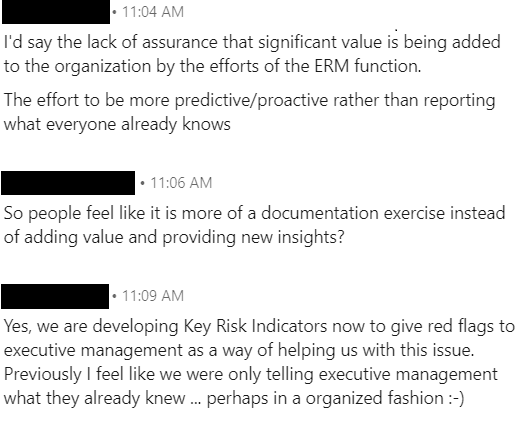One of the most persistent complaints or grievances executives air about ERM is that it only provides historical documentation of things they already know. This has been expressed to me personally several times, including in a survey a few years in which one risk professional stated:

By default, this “rear-facing” view cannot consider risks to objectives, which (as explained here) is a fundamental component of an effective ERM program that delivers valuable insights to decision-makers.
To play an active role in decisions before they are made, ERM has to provide insights in a timely manner. Taking several weeks (or even months!) gathering information and compiling a report will only compound the perceptions discussed in my previous survey.
This fact stuck out to me like a sore thumb in a recent conversation with a new risk leader in the insurance industry.
Prior to our discussion, this person had provided a schedule of ERM activities for the next 18 months. That schedule showed me that it would take one ERM team member 18 or more weeks to do a deep dive on a single risk.
I couldn’t believe it – 18 weeks!! That’s close to half a year!!
It’s situations like this that illustrate why results from NC State’s annual State of Risk Oversight Report consistently show how few companies realize any competitive advantage or strategic value from its ERM processes.
One reason this situation is so prevalent is because many people try to work on as many things as possible at a given time. With all of the assignments and work items, people feel like multi-tasking is a necessity to get anything done. But what I’ve learned over the years is that, while multitasking is a good skill to possess in some, limited circumstances, working on too many things at once only ensures that nothing will ever be accomplished in a timely manner.
The following interview with Todd Herman explains this more in-depth.
Take our example above…
The reason why it takes close to half a year to complete something that should only take a couple of weeks is because this particular team fell into a common trap of having each person “focusing” on 5, 6, or even 7 things simultaneously.
But the result is that by the end of the work, the information was outdated, not useful for decision-making, and really a regurgitation of information the business already knew but was new to ERM. How is that output helpful to anyone?
Addressing issues like this will require ERM to be adaptable and more focused on how it manages its time.
Changing this may seem simple but it isn’t easy. It can be hard for people to change how they do things, especially if they don’t possess a growth mindset. However, this type of fundamental change is required in order to improve the perception of ERM and deliver the insights executives need to make informed decisions.
One retort in these circumstances, including our example above, is that this is how things have always been done or that it’s impossible to get stuff done quicker.
That’s the mindset.
I don’t know about you though, but I personally get tired of having the same thing on my to-do list week after week after week. It’s gratifying to check something off my list and move on.
So if you’re trying to move a team off a limiting mindset like the one I’m describing, one way to do it is to ask if they’re tired of juggling so many things. Wouldn’t it be nice to get something on and off your list within a week or two?
Referencing our example of the risk deep dive – the business should know their stuff, so it shouldn’t take long at all to obtain the information, compile it, and report it out. Planning and lining up schedules may take a few days, but this time of scheduling is a prime opportunity for ERM to be gathering information from previous discussions, external resources, and any other research that will be helpful for the discussions. Include in your scheduling a session with the business leaders to review and provide live edits to the report. Take a week for planning, scheduling, information gathering and reading.
From here, take a week for conversations with the business (typically 2 or 3 sessions) for information gathering, analysis, and takeaways/action items, document the discussions, and compile the information into an actionable risk report. After sending the report out, have a quick (already scheduled) meeting with business units and decision-makers to review the report or presentation, make live edits, and then finalize.
The business units and decision-makers will like this because it provides helpful insights quickly while the risk team will appreciate getting tasks off its collective to-do list, opening up more capacity to move faster. Business units will also be more inclined to bring ERM in since they’re providing insights in real-time rather than months later when it’s obsolete.
Getting here fundamentally means being very disciplined in planning, execution, and how you revisit and reiterate a particular point.
There are many ways or systems to accomplish this…
One such system is the 90-Day Year developed by Todd Herman. Originally a performance coach to athletes, Todd eventually discovered how the same principles could be applied to business.
In short, the 90-Day Year program or framework helps the user accomplish what they would in a year in a 90-day timeframe, with smaller 2-week sprints within the 90-days.
In discussing his approach, Todd Herman states:
You are judged by what you do, not by what you think or you intend to do. At the end of the day, it’s what we do, how we execute, or how we perform that matters. All that happens on the field of play, the field of doing.
It’s not my intention to endorse one particular approach over another. However, you can visit the 90-Day Year website for a performance quiz to help you and your team better understand specific attributes of how you work.
Using systems like the 90-Day Year or others that work for you and your team to develop a “sprint” like approach to critical risk processes can help transform your program into a valuable partner in the company’s strategic planning and other decision-making.
Does your ERM program try to pursue too many things at once at the expense of its reputation within the company?
What are you doing to streamline processes and become a better partner in the company’s decision-making process?
We invite you to share your thoughts on this topic below or join the conversation on LinkedIn.
And to determine how you might re-structure your ERM program and the various tasks involved into a value-add machine, please feel free to reach out to discuss your current status, goals, and ways to help get you there.
Featured image courtesy of Freepik.com







